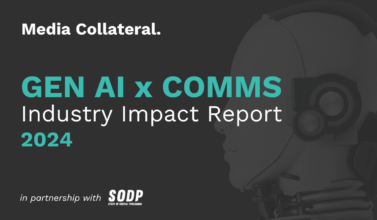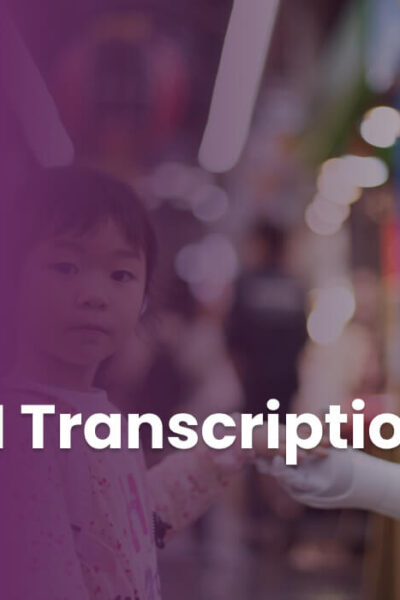In 2023, Media Collateral published a report: “Gen AI x Comms: Industry Impact Report.” For the 2024 edition, State of Digital Publishing (SODP) partnered up with Media Collateral to deliver insights to publishing, communications, and PR professionals, as well as journalists and content creators, on the impact of generative AI technologies on the industry.
As part of the research, Andrew Thompson (Research & Editorial Lead at Media Collateral) conducted a series of interviews with industry experts to help place the findings in a larger context and supplement the report with a qualitative analysis.
Jaemark Tordecilla is a member of the expert panel for the research study and below is his interview with Andrew Thompson.

Jaemark Tordecilla is a Fellow at the Nieman Foundation at Harvard University, where his focus has been on studying the implications of generative AI on the media industry – from ethical issues and pitfalls to potential applications.
Prior to Harvard, Jaemark spent his career as an innovator in the newsroom, working across different units within GMA Network to grow ideas into editorial initiatives that have become sustainable journalism products. He spent nearly a decade as the Head of Digital Media at GMA News and Public Affairs in the Philippines where he oversaw all online publishing and audience development activities, managing a unit of over 100 people.
In 2021, Jaemark won a TOYM Award, one of the Philippines’ top honors for young civic leaders, in recognition of his accomplishments and contribution to digital journalism.
Having studied the implications of Gen AI on the industry as a Fellow at the Nieman Foundation at Harvard University, what is your high-level conclusion on the state of technology and its impact on the media industry?
It’s been a bit frustrating, to be frank: there has been a lot of discussions about the technology and its impact on the media industry on the highest levels, but there’s very little work being done on the ground in terms of figuring out use cases for how these technologies could actually help news organizations. This is especially the case for news organizations in the Global South, where access to these technologies, or at least expertise in these technologies, is lagging behind. For example, there is still a lot of hesitation and uncertainty when it comes to using AI tools in newsrooms in the Philippines. I know only a handful of news organizations that have developed or published their AI guidelines.
Have you observed a divide between better resourced and less resourced newsrooms and communications outlets?
Yes, definitely. For example, the ChatGPT Pro product is an excellent product that anyone can access for $20 a month. But while $20/seat is cheap for a newsroom in, say, the US or Australia, it’s prohibitive for a newsroom in, say, the countryside in the Philippines. These newsrooms have to think twice whether to provide a subscription to all their reporters.
“I believe that media professionals from developing countries need to be a part of this conversation to push the development of Gen AI technology in a way that would actually suit their needs.“
Another example of uneven access to such technologies would be transcription software. Such tools can help facilitate processes in English-speaking countries. Reporters have to deal with a lot of transcriptions due to the nature of their job. However, reporters that conduct interviews in, for example, Tagalog, one of the most commonly spoken languages in the Philippines, have to dig further to find transcription tools. That’s because developing such tools is not a priority for big companies.
So there are layers to that disparity in access. And that’s very unfortunate, because I believe that media professionals from developing countries need to be a part of this conversation to push the development of Gen AI technology in a way that would actually suit their needs.
What would be your advice to professionals in the media space in terms of approaching Gen AI technologies and tools?
I think the first step is becoming familiar with the tools. What I found is that the more you use such tools, the more you realize that they’re not that good.
The big fear in media right now is that AI-powered tools are going to replace us and take our jobs. My response is to try asking a bot to try to find a story in a set of documents. What happens in these instances is that these tools just regurgitate what’s already there. But they fail to find the actual story. They can be good at summarizing the text, but are by no means a substitute for critical thinking.
That’s why I recommend that professionals in the space first try to really figure out what such tools can do well and what their limitations are. This will alleviate a lot of the fears around this technology.
What are your greatest hopes for how generative AI can benefit media communications practitioners and the industry as a whole?
As an industry, we constantly face the problem of resources. It is true in countries like Australia and the United States, but it’s an even bigger problem in the Global South. Newsroom staff in the Philippines, for example, have to wear many hats. So my hope is that generative AI tools will help newsrooms multiply their output, make them more productive, and make their work more sustainable.
Furthermore, I hope there could be a network that would allow people to exchange knowledge on use cases.
Finally, I hope that we will be able to figure all of this out faster than bad-faith actors: those who thrive on misinformation, those who create low-quality websites as a traffic grab, and so on.
What are some of the major risks you see with Gen AI across the media and communications landscape?
Ethics around how these models are trained is the first concern, of course, followed by how publishers get compensated for the work they did.
Furthermore, we discussed inequality in access earlier, and to that end, we see big news outlets in developed countries cut deals with the big tech companies. It makes me wonder what that means for newsrooms in, for example, the Philippines and elsewhere who are going to be left behind because they are not in a position to make these kinds of deals.
The next issue is misinformation and accountability. While a number of studies show that the fears of misinformation could be overblown, it’s still a concern. As is the “liar’s dividend”– a concept that describes an ecosystem where deepfakes become increasingly realistic, which, in turn, would allow people to claim that real content is AI-generated.
Content from our partners
At the same time, I believe this could be an opportunity. The more that people become aware of how easy it is to post fakes online, the more they will be cautious about believing everything they see online. This will present an opportunity to encourage them to go back to trusted sources that vet their information, the information that’s created by real journalists. Perhaps I’m just being optimistic, but that’s my hope.
Are you surprised by the speed at which Gen AI technologies have been spreading in the last 12-18 months?
I think the tools are improving more rapidly than their use in media organizations, which is somewhat of a concern because it’s hard to cover something that you don’t understand. And we can’t afford to be left behind.
At the same time, it is encouraging to see that access to these tools is getting cheaper – in some cases, they’ve become free. I’m hoping this would spur more adoption among local newsrooms here in the Philippines and elsewhere in the developing world.
How do you see Gen AI impacting the way media and communications practitioners work in the next 5 years? Any predictions or future trends you would like to share?
I think the hype will die down. I hope that would bring about a realization among people that these are simply tools that will help us improve what we do. For example, nobody is concerned when we use a word processor solution instead of a typewriter, or if a journalist uses an Excel sheet for their investigative work. So I’m hopeful that we get to the same point with Gen AI tools.
“I think these tools will put a spotlight on where the value really is in terms of the work that we do: actual reporting, getting to the heart of stories“
Hopefully, this means a good reporter in some far away region in the Philippines who doesn’t speak or write in English will use these tools – translation solutions, for example – to share their work across larger platforms.
I think these tools will put a spotlight on where the value really is in terms of the work that we do: actual reporting, getting to the heart of stories, going deep into our communities and talking to people in a way that gets them to open up. Robots can do that.












